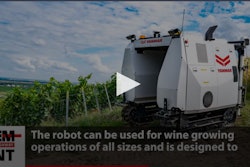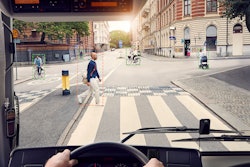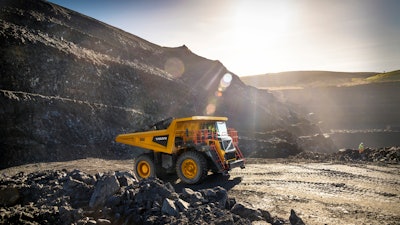
As part of its ongoing efforts in “Building Tomorrow,” Volvo Construction Equipment (Volvo CE) has partnered with professional futurists to gather their forecasts for the industrial industries. Futurists forecast the coming trends in science, technology and business. They help companies understand how the innovations of today will impact the industries of the future.
David Zach and Glen Hiemstra — known for their work with dozens of innovative Fortune 500 companies — provided their forecasts for the heavy-duty off-road equipment industries, including mining, construction and agriculture.
Mining
Mining is an industry set for a significant amount of change, as automation and nanotechnology change the nature of the work and humans become more removed from its hazardous aspects.
“You get all kinds of freedoms by taking the humans out of the mining equation,” says Hiemstra. “You don’t need cabs on machines and places for humans to sit. They can avoid toxic fumes and other dangers. This kind of work will move to autonomous and remote-controlled machines.”
Future mining will most likely be a mixture of autonomous machines, remote-controlled machines and advanced robotics. Autonomous machines will handle the duty-cycle, repetitive tasks, while humans pilot remote-controlled machines via simulators in far more pleasant environments. These simulators will give their operators tactile feedback based on conditions on the ground, such as moving forward and backward over bumpy terrain.
“Large robots of all types of shapes and sizes will likely take over the heavy-duty applications, such as moving materials from underground to the surface,” says Hiemstra. “These could be gargantuan machines that are simultaneously driving, digging and refining.”
The increased bandwidth of 5G connectivity (and beyond) will enable the instant communication between humans and machines on the ground, as well as machine-to-machine communications. Furthermore, these machines will feature more advanced analytics tools to determine what’s being mined and then send that information back to operators that can make quick adjustments.
READ MORE: 5G Enables the Next Wave of Connectivity
“Mining is based on human activity and we build machines to dig holes, then figure out what direction to go in,” says Zach. “In the future we will be analyzing the ground at a molecular level to understand what we are digging through. The human eye is a limited sensor, but with more advanced analytics, we can understand the full spectrum. Futurism is about recognizing complex patterns and placing bets on where those patterns are going, and we’ll be able to do that with geographic space to figure out what is under the surface.”
New frontiers
When the future arrives, mining operations won’t always be from the ground. We will increasingly look to the ocean floor for resources that aren’t readily available on dry land.
“We will use nanotechnology to analyze the ocean floor,” says Zach. “If you look at one square mile of ocean, just about all the elements are there. It’s vastly rich in minerals.”
We will increasingly extract materials from asteroids and other planets — areas that are rich in precious materials, yet hard to reach by today’s standards. Autonomous and remote-controlled equipment that is programmed and operated by people back on Earth will make these types of mining safe, efficient and cost-effective.
“There will be a major effort to look for more of these rare earth materials in oceans or on asteroids and other planets,” says Hiemstra. “Recycling these materials may or may not be a challenge in the future, but either way, there will be a demand for a new way of doing things. In 20 years, we could be mining on the moon or on Mars. It could be very lucrative, and several companies have already launched to achieve these goals.”
 Volvo Construction Equipment
Volvo Construction Equipment
Construction
The construction industry is one of the sectors of the economy most overdue for a complete overhaul in North America, and one that is likely to see dramatic changes over the next 20-40 years.
Machines are already becoming fully electric in 2020, and in the coming decades, more of them will become autonomous, particularly around duty-cycle work, and they will increasingly talk to one another, manufacturers and robots alike on the job site. Both Zach and Hiemstra point to a future where equipment and construction methods are increasingly affected by the advances in the Internet of Things (IoT), robotics, artificial intelligence and more modular predesign.
“Construction is one of the industries that is most ripe for innovation,” says Zach. “There is going be increasing modularity and prefabrication, and a lot of this will come from the advances in the 3D realm.”
The buildings that we will construct in the future will be increasingly complex, making use of techniques and technologies that we are just beginning to unleash. The construction of “supertall” skyscrapers, commercial buildings and residential housing will be increasingly modular, utilizing more prefabricated elements, including entire rooms and their furnishings, that are built in a specialized location, then installed at the job. This will reduce costs, speed up project delivery times and simplify building processes.
An example of this could be that a complete bathroom is built at a factory then transported on a truck to the job site. A crane lifts the bathroom through the frame of the building that is still being built, and it is locked into place. Robots hook up the water and electricity to the unit. This type of building is already being tested and will only grow in popularity.
For smaller building types, entire neighborhoods of houses will be 3D printed, then completed with prefabricated elements to quickly provide affordable housing in emerging regions of the world. This has already been accomplished in Mexico and developers are looking to role this model out in other parts of the world. Increased processing and simulation capabilities will allow for new ideas and approaches in architecture, introducing more strange angles, swoops, curves and cutouts into buildings, delivering bold visual statements.
“Better computing intelligence and simulation will allow for a new playfulness in architecture, introducing more strange angles, swoops, curves and cutouts into buildings, creating exciting visual impacts,” Hiemstra says. “Wires and plugs will disappear. Only 20% of future building construction will be what you can see with your eyes.”
The other 80%, continues Hiemstra, will be devoted to communications, HVAC, energy and green technologies. New polymers in paint will improve inside air quality. Sensors in the walls will monitor for unhealthy air, chemicals, smoke and fire. New laminates that resist fire and deterioration will once again make wood — a renewable resource that requires less energy to prepare — a premier building material.
And no matter the type of building being constructed, the amount of parking space available to commuters will decrease, as mass transit, ride sharing, and autonomous vehicles will reduce individual car ownership. Where there are parking structures, they will be made to produce their own energy for charging electric vehicles.
On the job site: New eyes, ears and arms
Drone technology, robotics and artificial intelligence will dramatically change the nature of work, futurists say, and we’re just beginning to understand how they will change construction.
“Drones are a no-brainer for construction,” says Zach. “You have the machines with your eyes right there on site. They might be controlled by an app or they could be controlled by artificial intelligence.”
Flying drones will monitor construction on job sites, sending critical data and visualizations back to contractors as projects progress. Rolling drones will travel up and down building shafts and behind walls to take readings and relay important information that can be fed back to project managers or integrated into 3D modeling software to improve performance or solve unique challenges.
Robots that resemble humans and canines will become a fixture on job sites, taking over heavy physical labor and collecting useful data. Artificial intelligence will help these robots make critical decisions and relay information back to architects and construction companies.
Conversely, humans may look more like robots, wearing full body suits that enhance their physical capabilities and decision-making skills while they increase safety through the use of warning systems, protective armor and air bags. A worker might fall from a short height and air bags deploy to keep them safe, for example.
“We’ll see more humanoid robots emerge in approximately 10-20 years and they will be quite sophisticated,” says Hiemstra. “They will be under human supervision at first, as their artificial intelligence won’t be quite as flexible as humans. They may be controlled by virtual reality or some other new remote-controlled operator techniques.”
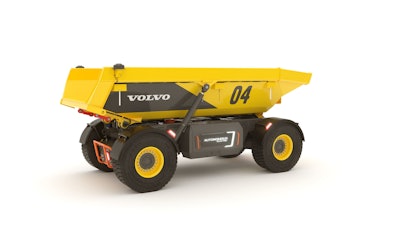 The Volvo TA15 Autonomous Hauler.
The Volvo TA15 Autonomous Hauler.
Communication and automation
Aided by advances in telecommunications, including new satellite systems that provide low-latency internet connections, machines on job sites will talk with one another, sharing their locations, travel paths and more. New telematics systems will further boost machine uptime, as real-time analytics are shared with OEMs and contractors, and machines are continuously monitored on the job site for maintenance and performance.
Improved connectivity will also enable autonomous machines to handle duty-cycle tasks, such as moving materials on job sites, and remote-controlled machines to be piloted by humans off site, increasing safety and efficiency. Virtual and augmented reality will give companies better access to hard-to-reach locations and enhanced abilities to solve challenges that arise on the job site, from no matter where they are in the world, and then use robots to implement the solutions.
“Automation will be a big sticking point,” says Zach. “Construction provides an ideal environment, as it’s closed and contained. With more sophisticated machinery, we can speed up projects and project management. The need for speed is going to drive automation.”
Agriculture
To support the growth in world population, agriculture will see tremendous innovation as humans seek to boost the efficiency at which we can grow food.
With rapid urbanization already occurring, a majority of the world’s population will live in cities in the coming decades. That means that farms are going to move closer to the urban populations they’re meant to feed, and with those moves, farms will no longer exclusively look like the large fields of crops we’ve come to know.
“The farm will be moving to the city,” says Zach. “This will make for the more efficient transportation of crops and will enable us to better control the environment in which those plants are growing. We currently use a bludgeon in the way we control pests and utilize nutrients and phosphates, and that’s not going to be sustainable.”
RFID technology and sensors will be embedded on each and every crop, enabling control of the amount of nutrients and water they receive down to a single drop, maximizing the efficiency of our natural resources. In many cases, only 1% of the current water, pesticides and nutrients needed to grow a plant will be used.
“In 2040, every major city will have large indoor farming operations,” says Hiemstra. “Vertical skyfarms near cities will boost the amount of food that can be grown on a single piece of land. They will use less energy, water, herbicides and pesticides and yield significant amounts of fresh produce.”
These indoor skyfarms will have multiple stories and give agriculture companies the ability to control weather, irrigation and pests and be able to grow cash crops at a faster rate. Combined with RFID technology, LED lighting and air quality controls, the plants will live in more conducive growth environments and be better protected from the elements and insects that often decimate a year’s harvest.
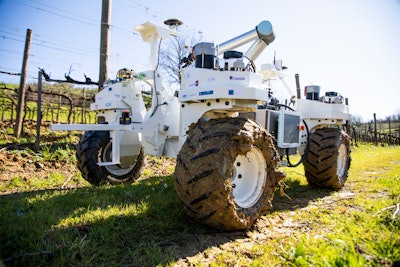 Agricultural robots can help with tasks or access areas that may be difficult for a farmer to reach.Yanmar
Agricultural robots can help with tasks or access areas that may be difficult for a farmer to reach.Yanmar
Automated agriculture
Automated machines will also take over much of the laborious and difficult work of farming, especially the harvesting of crops. Robots that use artificial intelligence will pick fruits and vegetables and sort them for either human use or composting on the spot. In these better controlled agricultural environments, crop growth can be optimized according to human dietary habits to reduce food waste. Smaller batches can be grown in more continuous cycles to ensure that the amount of food grown is exactly what is needed, eliminating large harvests of unwanted or unused crops.
“Machines will handle a lot of the tasks in agriculture,” says Zach. “They will be automated, connected and physically able to pick something as delicate as a berry off the vine.”
Autonomous and fully electric construction equipment, such as wheel loaders and haulers, will help prepare lands and transport harvests to food centers. They will help construct vertical farms, much like building a new skyscraper or mixed-use development. Sensors on the machines will send critical data to agriculture management companies to ensure a bountiful and efficient harvest. These advances could reduce the cost of food for people in many countries.
New technologies will enable us to better develop halophytes, crops grown in saltwater, where the water is nutrient rich. These plants will help tackle freshwater shortages around the globe and help feed populations that may struggle with providing fresh water.
The saltwater farms can be combined with solar and wind farms to provide food and energy from the same patch of land, while lessening the demands for fresh water. New pieces of equipment that hold up well to corrosion will boost efficiency in constructing and harvesting these saltwater farms — both in terms of the halophyte growing infrastructure, and the solar panels or wind turbines constructed on the farms.
“Over the next 20 years, farming will look very modern and very old fashioned at the same time,” says Hiemstra. “There will be a major effort because of climate change to grow crops in a way that sequesters more carbon and uses less fresh water. We will tackle energy, food and water all at one time by rethinking agriculture.”
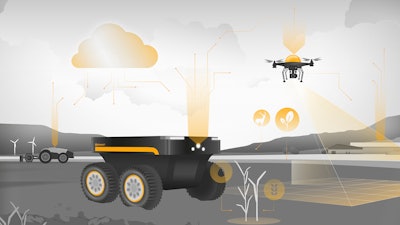 Continental
Continental
Infrastructure
The road infrastructure industry is also overdue for a complete overhaul, and one that is likely to see a tremendous amount of change over 20-40 years.
Notably, both Zach and Hiemstra suggest that the infrastructure of tomorrow will provide much more benefit to society than simply surfaces for vehicles to travel on. Roadways offer valuable real estate that can be used to generate energy, improve logistics and gather data to be used in predictive analytics.
“In the near term, there will be some changes around making roadways more intelligent and more integrated with vehicles,” says Hiemstra. “The price of components that drive the Internet of Things (IoT) will be reduced over time and 5G communications will deliver enormous bandwidth. Censors will be embedded into the roads and intersections, gathering valuable data and communicating directly with vehicles.”
READ MORE: Cities of the Future will be Smarter, More Connected
To enable these embedded sensors, future roadways will utilize nanotechnology principles to provide better molecular structures for rigorous use — “nano-concrete.” The roads will be paved in nano-concrete, which could be glass-like materials that are more resilient to weather, climate change and wear and tear.
These sensors will monitor weather information, surface temperature, surface conditions, traffic conditions, upcoming hazards, animal crossings and other potential slowdowns. They can then send this up-to-date information to vehicles, suggesting lane switches and alternative routes. LED lights that are embedded into the glass, and at a moment’s notice can redirect traffic or reverse lanes to improve traffic flow and safety.
As the sensors gather more data over months and years, they can provide valuable information that can improve the transport of people and goods. And it’s over these years that will see the most dramatic changes.
“This connectivity in our infrastructure will change the whole notion of demographic flow. If you can measure it you can manage it,” says Zach. “There will be the continued urbanization of the world’s population, with some forecasts suggesting 80% of people will be living in cities. We will have to develop separate infrastructures for people and for goods. We’ll be getting rid of traditional trade routes.”
These changes in trade routes could mean changes focusing on the distribution of raw goods, which is much more cost effective, and returning to more local and regional factories closer to the point of consumption. Combined with 3D printing, this could mean a reduction in packaging and plastics usage and more easily transported goods.
Meanwhile, people could be using more intelligent roadways that makes use of their connectivity and sensors to optimize peak travel times, or even alert offices that their workers are approaching, for example. In these scenarios, people and goods are being transported in dramatically different ways.
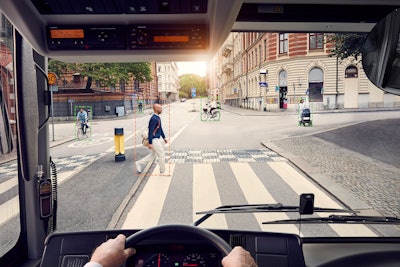 Integration of more sensors will help to increase safety for drivers and pedestrians.Volvo Buses
Integration of more sensors will help to increase safety for drivers and pedestrians.Volvo Buses
New materials, new methods
One thing that is clear about the future is that the infrastructure of tomorrow won’t just be a replacement of what we have today. Infrastructure will be built out of new materials that are created in new ways and constructed using new methods.
“In the western world, there is an infrastructure deficit. We have delayed maintenance, so we are going to see a lot of infrastructure building and rebuilding,” says Hiemstra. “And part of that is to deal with things that are 100 years or older breaking down. In the future, we will be building a lot more resilience into our infrastructure for climate and major storm events.”
Self-healing epoxies that coat concrete and steel are being developed and will enable bridges and other metal structures to “heal” themselves from damage, while better resisting weather and rusting. Buildings and other structures will be more intelligent, and using their sensors and connectivity, will monitor themselves for decay. More carbon polymers that are rust-resistance will be used to enable lightweight bridge construction and protect against weather and earthquakes, too.
Energy usage and consumption will be a major factor in future infrastructure development. New methods of preparing steel and concrete, like using mirrors to power high-intensity furnaces, will reduce the amount of energy and carbon emissions associated with infrastructure development — the burning of fossil fuels will no longer be needed for these applications. Fully electric construction equipment will eliminate the carbon emissions associated with construction of new infrastructure, too.
“The roadways themselves will become a power source, as photogenic cells along the roads will capture solar energy for transporting to local power grids that power cities and neighborhoods,” says Hiemstra. “And since these roadways are intelligent and connected, they could heat and cool themselves to reduce maintenance costs. Rooftops, parking lots and other large paved spaces could be turned into generators, as well.”
New ways to build
The new connectivity in infrastructure and its materials will also change the way companies build roadways and other structures. The sensors in infrastructure will speak to the sensors embedded in construction equipment will provide valuable data for machine manufacturers and contractors, which will result in predictive analytics that lead to actionable insights in the field.
Maintenance will be systematic, and companies will see dramatic improvements in their uptime. New pieces of equipment can be brought onto an infrastructure project to replace working machines before they break down. The replacement machine is there waiting, and they are quickly swapped out. The first machine is then repaired/maintained. The process is seamless, and work continues around the machines on the job site.
The improvements in uptime will enable companies to complete projects much faster, as job site stoppages are reduced and eliminated. Furthermore, autonomous equipment that is fully electric and emissions free will handle much of the duty-cycle work, minimizing carbon footprints at job sites. The equipment will communicate with each other to optimize job site applications and send critical information back to the contractors and manufacturers.
“Everything you could imagine being built might have something to say,” says Zach. “The roads, vehicles and equipment are all going to be talking to each other — everything will want to talk.”
Waste management and recycling
The waste management and recycling industries should see sweeping changes over the next 20-40 years as the world will move towards a more circular economy and companies seek to minimize pollution, preserve the environment and better utilize natural resources.
“While consumers will want to reduce the use of non-recyclable materials, companies will have more responsibility over the entire lifecycles of their products and the materials used to make them, creating a more circular economy of goods,” says Zach.
This means that companies will offer more services that help their customers prolong the lifecycle of goods through maintenance and uptime measures, for example. They will also have a hand in what will be done with those goods when lifecycles end.
Some countries are already mandating that certain industries must accept products for recycling and reuse, but in general, as consumers seek to do business with companies that prioritize sustainability, many companies will make these moves voluntarily.
“This will be about producing less waste as opposed to just thinking about reuse and recycling,” says Hiemstra. “It will have us rethinking how we move things around in terms of transporting goods and the containers they’re in. This is an ever-growing business and it will be one of the biggest in the future.”
Moving materials
Much of the focus for the waste and recycling industries will be on cities. As more people move to metropolises and urbanization increases, getting food and materials into cities and then transporting the waste and recycling back out of them will become one of the largest industries on the planet, and it will make use of innovative technologies to generate efficiency and value.
The vehicles that we use to collect waste and recycling will be fully electric, which will not only reduce emissions, but reduce noise, too. This means that collections can happen while people are asleep, and that noise pollution won’t disturb people in hospitals or schools.
Fewer emissions and less noise will also enable more frequent waste and recycling collections, which means that waste and recycling plants can process materials in smaller units, improving their efficacy and logistical efficiency. This will make it easier and more efficient to reinsert materials into product streams.
Remote-controlled and autonomous equipment will also have a major role to play. Humans will be able to avoid the dirty work of hauling garbage and sorting it by piloting a simulator that resides in a far more pleasant environment, such as an office building. And while autonomous vehicles are already beginning to play a role in waste management, haulers and trucks won’t be the only self-driving machines in our cities.
 The Volvo Group announced it 2015 it was working on a project for Robot-based Autonomous Refuse handling.Volvo Group
The Volvo Group announced it 2015 it was working on a project for Robot-based Autonomous Refuse handling.Volvo Group
“Waste and recycling bins themselves will become fully electric and autonomous. They will charge with solar power throughout the day, then they’ll drive themselves to the end of city streets or neighborhood blocks where they will be collected by a larger, autonomous hauler,” Hiemstra says.
Upon arrival at the waste and recycling plants, robots that have cameras for eyes will use artificial intelligence to separate the waste. These new types of robots will “eat” some of the materials and use them for fuel. This will include plastics and other matter than can be compressed or melted down to their raw goods state, while other materials will be set aside for reuse.
One big game
The move toward remote-controlled equipment will “gamify” the collection and sorting of materials, too. An improvement in work conditions will attract new talent to the industry that will lead to further innovation, as the work becomes both more scientific and video game-like at once.
A hauler or truck could be operated by someone in an office building via a simulator. This person would use the simulator to control machines that manipulate the waste, making the work appears like a game. On screen, the graphics are exciting, the numbers rise, and awards are being won. Workers could attempt to break their high score and perhaps see a pay bonus when they do.
“Young people are more understanding of gamification, but everyone would like to have a sense of ‘Why am I doing this?’” Zach says.
In this manner, companies will seek to gamify recycling, creating targets around the sorting of materials. New machines that accept recyclables will let customers see exactly what those materials are going to be used for in the future. For example, a machine that accepts water bottles might show how the material will be used to make fabric.
“The goal is to increase that behavior with people and organizations with incentives,” Zach says. “It is creating positive incentives, but also introducing an element of fun to the process.”




